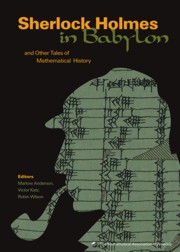Book contents
- Frontmatter
- Introduction
- Contents
- Ancient Mathematics
- Medieval and Renaissance Mathematics
- The Seventeenth Century
- The Eighteenth Century
- Foreword
- Brook Taylor and the Mathematical Theory of Linear Perspective
- Was Newton's Calculus a Dead End? The Continental Influence of Maclaurin's Treatise of Fluxions
- Discussion of Fluxions: from Berkeley to Woodhouse
- The Bernoullis and the Harmonic Series
- Leonhard Euler 1707–1783
- The Number e
- Euler's Vision of a General Partial Differential Calculus for a Generalized Kind of Function
- Euler and the Fundamental Theorem of Algebra
- Euler and Differentials
- Euler and Quadratic Reciprocity
- Afterword
- Index
- About the Editors
Brook Taylor and the Mathematical Theory of Linear Perspective
from The Eighteenth Century
- Frontmatter
- Introduction
- Contents
- Ancient Mathematics
- Medieval and Renaissance Mathematics
- The Seventeenth Century
- The Eighteenth Century
- Foreword
- Brook Taylor and the Mathematical Theory of Linear Perspective
- Was Newton's Calculus a Dead End? The Continental Influence of Maclaurin's Treatise of Fluxions
- Discussion of Fluxions: from Berkeley to Woodhouse
- The Bernoullis and the Harmonic Series
- Leonhard Euler 1707–1783
- The Number e
- Euler's Vision of a General Partial Differential Calculus for a Generalized Kind of Function
- Euler and the Fundamental Theorem of Algebra
- Euler and Differentials
- Euler and Quadratic Reciprocity
- Afterword
- Index
- About the Editors
Summary
One can distinguish four overlapping and interrelated periods in the development of the mathematical theory of linear perspective:
(l) the “prehistory” period in which, for example, the Greeks are reported to have made some use of perspective drawing in their theater,
(2) the 15th and 16th century period of the origin of the theory with the artists-architects-engineers of the Renaissance (Brunelleschi, Franceschi, Alberti, and da Vinci),
(3) a period of geometrical expositions typified by the works of del Monte and Stevin in the 17th century, and, finally,
(4) the period of a generalized, complete, and even abstract theory.
This last period falls largely in the 18th century and is typified by the work of William Jacob Gravesand in Holland, Humphrey Ditton and Brook Taylor in England, and of the Alsacian (he was born in Mülhausen in the period when it was allied with Switzerland) mathematician Johann Heinrich Lambert.
Of these, the work of Brook Taylor was certainly the most widely translated and reproduced, although the later work of Lambert rivals it in interest and perhaps in its total effect [1].
Brook Taylor published only two books in his lifetime of 46 years. Both of these appeared in 1715 when he was 30, and both of them exerted wide influence. He is, of course, best known for his Methodus Incrementorum Directa et Inversa in which appears the well known expansion of f(x + h) which bears his name.
- Type
- Chapter
- Information
- Sherlock Holmes in BabylonAnd Other Tales of Mathematical History, pp. 303 - 309Publisher: Mathematical Association of AmericaPrint publication year: 2003

